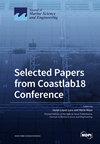Typhoon Intensity Change in the Vicinity of the Semi-Enclosed Sea of Japan
IF 2.8
3区 地球科学
Q1 ENGINEERING, MARINE
引用次数: 0
Abstract
The intensity change of Typhoon Songda (TY-0418) in the vicinity of the semi-enclosed Sea of Japan (SJ) was numerically investigated using 3D-WRF and UM-KMA models and GOES-IR satellite images on 4 to 8 September 2004. After the typhoon originated in the Western Pacific Ocean in August, it moved to the East China Sea. Following the north-eastward Kuroshio Warm Current, it developed with horizontal and vertical asymmetrical wind and moisture patterns until 5 September. On 7 September, closing to the Kyushu Island, it was divided into three wind fields near the surface due to the increased friction from the surrounding lands and shallower sea depth close to the land, but it still maintained its circular shape over 1 km in height. As it passed by the Korea Strait and entered the SJ, it became a smaller, deformed typhoon due to the SJ’s surrounding mountains, located between the East Korea and Tsushima Warm Currents inside the SJ. Its center matched a high equivalent potential temperature area, releasing significant latent heat through the condensation of water particles over warm currents. The latent heat converted to kinetic energy could be supplied into the typhoon circulation, causing its development. Moist flux and streamline at 1.5 km in height clearly showed the moisture transportation via the mutual interaction of the cyclonic circulation of the typhoon and the anti-cyclonic circulation of the North Pacific High Pressure from the typhoon’s tail toward both the center of the SJ and the Russian Sakhalin Island in the north of Japan, directly causing large clouds in its right quadrant. Simultaneously, the central pressure decrease with time could converge both transported moist air by the typhoon itself and water particles evaporated from the sea, causing them to rise and resulting in the formation of large clouds and the rapid development of the typhoon circulation. The strong downslope winds from the surrounding mountains of the SJ to its center also produced a cyclonic vortex due to the Coriolis force to the right, enhancing the typhoon’s circulation.日本半封闭海附近的台风强度变化
利用三维-WRF 和 UM-KMA 模式以及 2004 年 9 月 4-8 日 GOES-IR 卫星图像,对台风 "桑达"(TY-0418)在半封闭日本海(SJ)附近的强度变化进行了数值研究。台风于 8 月在西太平洋登陆后,向中国东海移动。它顺着黑潮暖流向东北方向移动,在水平和垂直方向上形成了不对称的风和水汽模式,直至 9 月 5 日。9 月 7 日,它向九州岛靠近,由于周围陆地的摩擦力增大,靠近陆地的海域水深变浅,它在近海面被分成了三个风场,但高度仍保持在 1 公里以上的圆形。当它经过朝鲜海峡并进入 SJ 时,由于 SJ 周围的山脉位于 SJ 内的东朝鲜暖流和对马暖流之间,它变成了一个较小的变形台风。它的中心与高等效潜在温度区域相匹配,通过暖流上的水颗粒凝结释放出大量潜热。转化为动能的潜热可提供给台风环流,导致其发展。1.5 千米高空的水汽通量和流线清楚地显示,水汽通过台风的气旋环流和北太平洋高压的反气旋环流的相互作用,从台风尾部向 SJ 中心和日本北部的俄罗斯库页岛输送,直接导致其右侧象限出现大量云层。同时,随着时间的推移,中心气压降低,台风本身输送的潮湿空气和从海上蒸发的水颗粒都会聚集在一起,使其上升,从而形成大量云层,台风环流迅速发展。由于科里奥利力的作用,从 "南沙 "周围山脉向其中心吹来的强下沉风也在右侧产生了一个气旋涡旋,增强了台风的环流。
本文章由计算机程序翻译,如有差异,请以英文原文为准。
求助全文
约1分钟内获得全文
求助全文
来源期刊

Journal of Marine Science and Engineering
Engineering-Ocean Engineering
CiteScore
4.40
自引率
20.70%
发文量
1640
审稿时长
18.09 days
期刊介绍:
Journal of Marine Science and Engineering (JMSE; ISSN 2077-1312) is an international, peer-reviewed open access journal which provides an advanced forum for studies related to marine science and engineering. It publishes reviews, research papers and communications. Our aim is to encourage scientists to publish their experimental and theoretical results in as much detail as possible. There is no restriction on the length of the papers. The full experimental details must be provided so that the results can be reproduced. Electronic files and software regarding the full details of the calculation or experimental procedure, if unable to be published in a normal way, can be deposited as supplementary electronic material.
 求助内容:
求助内容: 应助结果提醒方式:
应助结果提醒方式:


